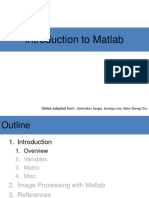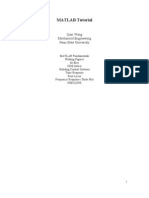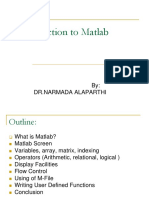0% found this document useful (0 votes)
35 views32 pagesLab 3: Matlab Tutorial
This document provides an overview of MATLAB functions for optimization problems. It discusses functions for linear and quadratic minimization, nonlinear equation solving, linear least squares problems, and nonlinear function minimization with constraints. Specific functions mentioned include linprog, quadprog, fzero, fsolve, lsqlin, lsqnonneg, fminbnd, fmincon, fminsearch, fminunc, and fseminf.
Uploaded by
Fachransjah AliunirCopyright
© © All Rights Reserved
We take content rights seriously. If you suspect this is your content, claim it here.
Available Formats
Download as PDF, TXT or read online on Scribd
0% found this document useful (0 votes)
35 views32 pagesLab 3: Matlab Tutorial
This document provides an overview of MATLAB functions for optimization problems. It discusses functions for linear and quadratic minimization, nonlinear equation solving, linear least squares problems, and nonlinear function minimization with constraints. Specific functions mentioned include linprog, quadprog, fzero, fsolve, lsqlin, lsqnonneg, fminbnd, fmincon, fminsearch, fminunc, and fseminf.
Uploaded by
Fachransjah AliunirCopyright
© © All Rights Reserved
We take content rights seriously. If you suspect this is your content, claim it here.
Available Formats
Download as PDF, TXT or read online on Scribd
/ 32

















































































